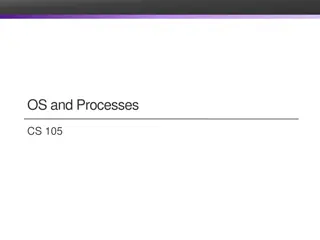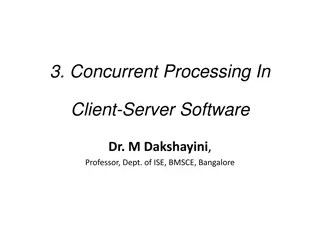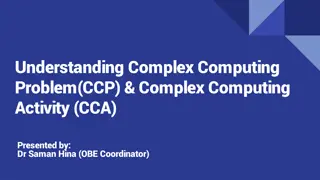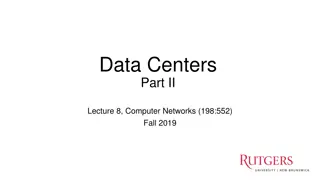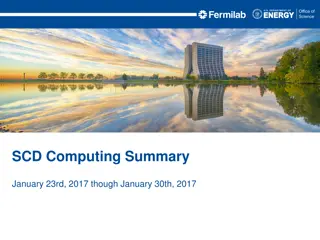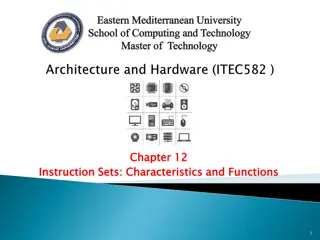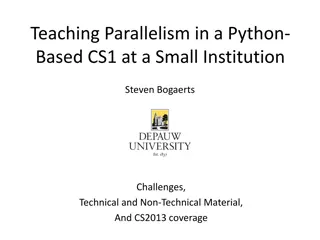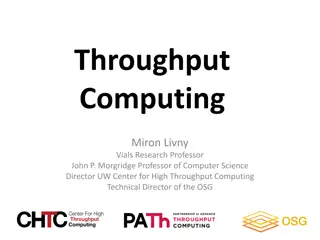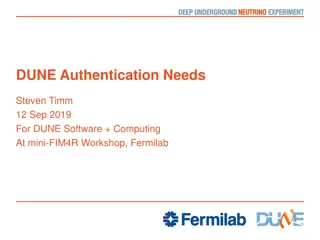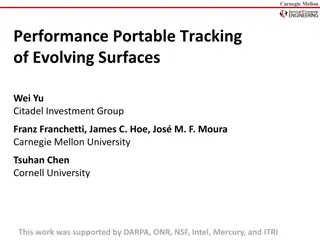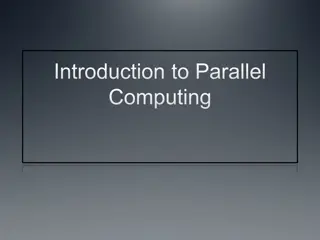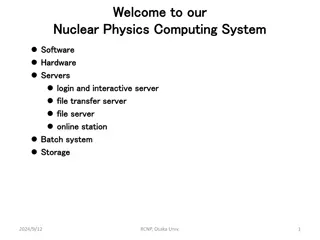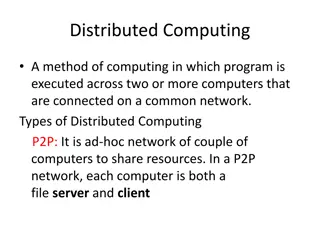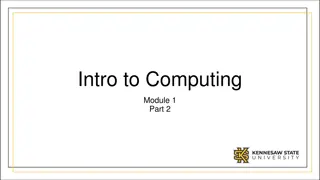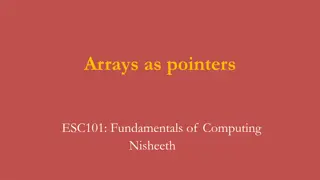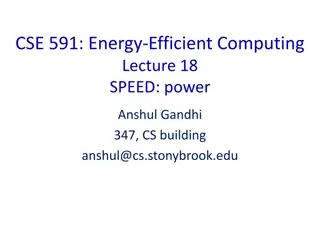Understanding Processes and Multiprocessing in Computing
Processes in computing provide the illusion of exclusive CPU and memory use for each program through logical control flow and address space management. Multiprocessing allows a computer to run multiple processes simultaneously, catering to various user applications. This concept challenges the traditional reality of single processor execution and requires register saving for nonexecuting processes.
Download Presentation

Please find below an Image/Link to download the presentation.
The content on the website is provided AS IS for your information and personal use only. It may not be sold, licensed, or shared on other websites without obtaining consent from the author. Download presentation by click this link. If you encounter any issues during the download, it is possible that the publisher has removed the file from their server.
E N D
Presentation Transcript
CS 105 Tour of the Black Holes of Computing! Processes Topics Process context switches Creating and destroying processes
Processes Def: A process is an instance of a running program One of the most profound ideas in computer science Not the same as program or processor Process provides each program with two key abstractions: Logical control flow Each program seems to have exclusive use of the CPU Memory Private address space Each program seems to have exclusive use of main memory Stack Heap Data How are these illusions maintained? Process executions interleaved (multitasking) Address spaces managed by virtual memory system Code CPU Registers CS 105 2
Logical Control Flows Each process has its own logical control flow Process A Process B Process C Time CS 105 3
Multiprocessing: The Illusion Memory Memory Memory Stack Heap Data Stack Heap Data Stack Heap Data Code Code Code CPU CPU CPU Registers Registers Registers Computer runs many processes simultaneously Applications for one or more users Web browsers, email clients, editors, Background tasks Monitoring network and I/O devices Web and mail servers, VPN management, auto-backups, Skype, CS 105 4
Multiprocessing: The (Traditional) Reality Memory Stack Heap Data Stack Heap Data Stack Heap Data Code Code Code Saved registers Saved registers Saved registers CPU Registers Single processor executes multiple processes concurrently Process executions interleaved (multitasking, also known as timeslicing) Address spaces managed by virtual memory system (later in course) Nonexecuting processes register values saved in memory CS 105 5
Multiprocessing: The (Traditional) Reality Memory Stack Heap Data Stack Heap Data Stack Heap Data Code Code Code Saved registers Saved registers Saved registers CPU Registers Save current registers in memory CS 105 6
Multiprocessing: The (Traditional) Reality Memory Stack Heap Data Stack Heap Data Stack Heap Data Code Code Code Saved registers Saved registers Saved registers CPU Registers Schedule next process for execution CS 105 7
Multiprocessing: The (Traditional) Reality Memory Stack Heap Data Stack Heap Data Stack Heap Data Code Code Code Saved registers Saved registers Saved registers CPU Registers Load saved registers and switch address space (context switch) CS 105 8
Multiprocessing: The (Modern) Reality Memory Stack Heap Data Stack Heap Data Stack Heap Data Code Code Code Saved registers Saved registers Saved registers Multicore processors Multiple CPUs (cores) on single chip Share main memory (and some of the caches) Each can execute a separate process Scheduling of processors onto cores done by kernel CPU CPU Registers Registers CS 105 9
Context Switching Processes are managed by a shared chunk of OS code called the kernel Important: the kernel is not a separate process, but rather runs as part of (or on behalf of) some user process Control flow passes from one process to another via a context switch Process A code Process B code user code context switch kernel code Time user code context switch kernel code user code CS 105 10
Private Address Spaces Each process has its own private address space 0x7fffffffffff user stack (created at runtime) %rsp (stack pointer) memory mapped region for shared libraries 0x2aaaaad00000 brk run-time heap (managed by malloc) read/write segment (.data, .bss) read-only segment (.init, .text, .rodata) loaded from the executable file 0x400000 unused 0 CS 105 11
System-Call Error Handling On error, Unix system-level functions typically return -1 and set global variable errno to indicate cause. Hard and fast rule: You MUST check the return status of every system-level function!!! Only exception is the handful of functions that return void Example: pid = fork(); if (pid == -1) { fprintf(stderr, "fork error: %s\n", strerror(errno)); exit(1); } CS 105 12
Error-Reporting Functions Can simplify somewhat using an error-reporting function: void unix_error(char *msg) /* Unix-style error */ { fprintf(stderr, "%s: %s\n", msg, strerror(errno)); exit(1); } (Aborting on error is generally bad idea but handy for demo programs) if ((pid = fork()) == -1) unix_error("fork error"); Note: assignment inside conditional is bad style but common idiom CS 105 13
Error-Handling Wrappers We simplify the code we present to you even further by using Stevens- style error-handling wrappers: pid_t Fork(void) { pid_t pid; if ((pid = fork()) == -1) unix_error("Fork error"); return pid; } pid = Fork(); Lousy approach in real life but useful for simplifying examples CS 105 14
Obtaining Process IDs Every process has a numeric process ID (PID) Every process has a parent pid_t getpid(void) Returns PID of current process (self) pid_t getppid(void) Returns PID of parent process CS 105 15
Process States From a programmer s perspective, we can think of a process as being in one of three states: Running Process is either executing or waiting to be executed, and will eventually be scheduled (i.e., chosen to execute) by the kernel Stopped Process execution is suspended and will not be scheduled until further notice (future lecture when we study signals) Terminated Process is stopped permanently (due to finishing or serious error) CS 105 16
Terminating Processes Process becomes terminated for one of three reasons: Receiving a signal whose default action is to terminate (future lecture) Calling the exit function Returning from the main routine (which actually calls exit internally) void exit(int status) Terminates with an exit status of status Convention: normal return status is 0, nonzero on error (Anna Karenina) Another way to explicitly set the exit status is to return an integer value from the main routine exit is called once but never returns. CS 105 17
Creating Processes: fork() Parent process creates a new running child process by calling fork int fork(void) Returns 0 to the child process, child s PID to parent process Child is almost identical to parent: Child get an identical (but separate) copy of the parent s virtual address space. Child gets identical copies of the parent s open file descriptors, signals, and other system information Child has a different PID than the parent fork is interesting (and often confusing) because it is called once but returns twice Huh? Run that by me again! CS 105 18
fork Example Call once, return twice int main() { pid_t pid; int x = 1; Concurrent execution Can t predict execution order of parent and child pid = Fork(); if (pid == 0) { /* Child */ printf("child : x=%d\n", ++x); exit(0); } Duplicate but separate address space x has a value of 1 when fork returns in parent and child Subsequent changes to x are independent /* Parent */ printf("parent: x=%d\n", --x); exit(0); } Shared open files stdin, stdout, stderr are the same in both parent and child fork.c linux> ./fork parent: x=0 child : x=2 Important!!! CS 105 19
Modeling fork with Process Graphs A process graph is a useful tool for capturing the partial ordering of statements in a concurrent program: Each vertex is the execution of a statement a b means a happens before b Edges can be labeled with current value of variables printf vertices can be labeled with output Each graph begins with a vertex with no incoming edges Any topological sort of the graph corresponds to a feasible total ordering of the processes execution Total ordering of vertices where all edges point from left to right CS 105 20
Process Graph Example int main() { pid_t pid; int x = 1; child: x=2 printf parent: x=0 pid = Fork(); if (pid == 0) { /* Child */ printf("child : x=%d\n", ++x); exit(0); } Child exit x==1 exitParent main fork printf /* Parent */ printf("parent: x=%d\n", --x); exit(0); } CS 105 21
Interpreting Process Graphs Original graph: child: x=2 printf parent: x=0 exit Feasible total ordering: x==1 exit main fork printf a b e c f d Relabeled graph: Infeasible total ordering: e f a b c d a b f c e d CS 105 22
fork Example: Two consecutive forks Bye printf Bye void fork2() { printf("L0\n"); Fork(); printf("L1\n"); Fork(); printf("Bye\n"); } L1 printf fork printf Bye printf Bye L1 L0 printf fork printf printf fork Feasible output: L0 L1 Bye Bye L1 Bye Bye Infeasible output: L0 Bye L1 Bye L1 Bye Bye CS 105 23
fork Example: Nested forks in parent void fork4() { printf("L0\n"); if (Fork() != 0) { printf("L1\n"); if (Fork() != 0) { printf("L2\n"); } } printf("Bye\n"); } Bye Bye printf printf L2 L0 L1 Bye printf printf fork printf printf fork Feasible output: L0 L1 Bye Bye L2 Bye Infeasible output: L0 Bye L1 Bye Bye L2 CS 105 24
fork Example: Nested forks in children void fork5() { printf("L0\n"); if (Fork() == 0) { printf("L1\n"); if (Fork() == 0) { printf("L2\n"); } } printf("Bye\n"); } L2 Bye printf Bye printf L1 printf Bye fork printf L0 printf printf fork Feasible output: L0 Bye L1 L2 Bye Bye Infeasible output: L0 Bye L1 Bye Bye L2 CS 105 25
Reaping Child Processes Idea When process terminates, it still consumes resources Examples: exit status, various OS tables Called a zombie Living corpse, half alive and half dead Reaping Performed by parent on terminated child (using wait or waitpid) Parent is given exit status information Kernel then deletes zombie child process What if parent doesn t reap? If any parent terminates without reaping a child, then the orphaned child will be reaped by init process (pid == 1) So, only need explicit reaping in long-running processes e.g., shells and servers CS 105 26
Zombie Example void fork7() { if (Fork() == 0) { /* Child */ printf("Terminating Child, PID = %d\n", getpid()); exit(0); } else { printf("Running Parent, PID = %d\n", getpid()); while (1) ; /* Infinite loop */ } } linux> ./forks 7 & [1] 6639 Running Parent, PID = 6639 Terminating Child, PID = 6640 linux> ps PID TTY TIME CMD 6585 ttyp9 00:00:00 bash 6639 ttyp9 00:00:03 forks 6640 ttyp9 00:00:00 forks <defunct> 6641 ttyp9 00:00:00 ps linux> kill 6639 [1] Terminated linux> ps PID TTY TIME CMD 6585 ttyp9 00:00:00 bash 6642 ttyp9 00:00:00 ps ps shows child process as defunct Killing parent allows child to be reaped CS 105 27
Nonterminating Child Example void fork8() { if (Fork() == 0) { /* Child */ printf("Running Child, PID = %d\n", getpid()); while (1) ; /* Infinite loop */ } else { printf("Terminating Parent, PID = %d\n", getpid()); exit(0); } } linux> ./forks 8 Terminating Parent, PID = 6675 Running Child, PID = 6676 linux> ps PID TTY TIME CMD 6585 ttyp9 00:00:00 bash 6676 ttyp9 00:00:06 forks 6677 ttyp9 00:00:00 ps linux> kill 6676 linux> ps PID TTY TIME CMD 6585 ttyp9 00:00:00 bash 6678 ttyp9 00:00:00 ps Child process still active even though parent has terminated Must kill explicitly, or else will keep running indefinitely CS 105 28
wait: Synchronizing with Children Parent reaps a child by calling the wait function int wait(int *child_status) Suspends current process until one of its children terminates Return value is pid of child process that terminated If child_status!= NULL, then integer it points to will be set to value that tells why child terminated and gives its exit status: Checked using macros defined in wait.h WIFEXITED, WEXITSTATUS, WIFSIGNALED, WTERMSIG, WIFSTOPPED, WSTOPSIG, WIFCONTINUED See textbook for details CS 105 29
wait: Synchronizing with Children void fork9() { int child_status; HC exit if (Fork() == 0) { printf("HC: hello from child\n"); exit(0); } else { printf("HP: hello from parent\n"); wait(&child_status); printf("CT: child has terminated\n"); } printf("Bye\n"); } printf CT Bye HP printf wait printf fork Feasible output: HC HP CT Bye Infeasible output: HP CT Bye HC CS 105 30
Another Wait Example If multiple children completed, wait will take them in arbitrary order Can use WIFEXITED and WEXITSTATUS to probe status void fork10() { pid_t pid[N]; int i, child_status; for (i = 0; i < N; i++) { pid[i] = Fork(); if (pid[i] == 0) exit(100 + i); /* Child */ } for (i = 0; i < N; i++) { pid_t wpid = wait(&child_status); if (WIFEXITED(child_status)) printf("Child %d terminated with exit status %d\n", wpid, WEXITSTATUS(child_status)); else printf("Child %d terminated abnormally\n", wpid); } } CS 105 31
Waitpid waitpid(pid, &status, options) More flexible: can wait for specific process Various options available (see man page) void fork11() { pid_t pid[N]; int i, child_status; for (i = 0; i < N; i++) { pid[i] = Fork(); if (pid[i] == 0) exit(100 + i); /* Child */ } for (i = 0; i < N; i++) { pid_t wpid = waitpid(pid[i], &child_status, 0); if (WIFEXITED(child_status)) printf("Child %d terminated with exit status %d\n", wpid, WEXITSTATUS(child_status)); else printf("Child %d terminated abnormally\n", wpid); } } CS 105 32
exec: Running New Programs int execlp(char *what, char *arg0, char *arg1, , NULL) Loads and runs executable at what with args arg0, arg1, what is name or complete path of an executable arg0 becomes name of process Typically arg0 is either identical to what, or else contains only the executable filename from what Real arguments to the executable start with arg1, etc. List of args is terminated by a (char *)0 argument Replaces code, data, and stack Retains PID, open files, other system context like signal handlers Called once and never returns (except if there is an error) Differs from exit because process keeps running, but program executed is brand-new CS 105 33
execlp Example Runs ls lt /etc in child process Output is to stdout (why?) main() { pid_t pid; pid = Fork(); if (pid == 0) { execlp("ls", "ls", "-lt", "/etc", NULL); fprintf(stderr, "ls: command not found\n"); exit(1); } wait(NULL); exit(0); } CS 105 34
Summarizing Processes At any given time, system has multiple active processes But only one (per CPU core) can execute at a time Each process appears to have total control of processor + private memory space CS 105 35
Summarizing (cont.) Spawning Processes Call to fork One call, two returns Terminating Processes Call exit One call, no return Reaping Processes Call wait or waitpid Replacing Program Executed by Process Call execlp (or other exec variant) One call, (normally) no return CS 105 36
Putting It All Together: The Shell Command-line interface is called a shell Because it wraps the OS kernel in something more usable Ordinary user program Basic shell operation (loop): Read line from user Break arguments apart at whitespace Execute command named by first argument fork a subprocess exec the command with the parsed arguments wait for command to finish CS 105 37
Fancier Shell Features What if user wants whitespace in an argument? Put it inside quote marks: ' ' or " " Slight semantic differences between the two but we ll ignore that for CS 105 By default, stdin, stdout, and stderr connected to terminal Can redirectstdin with < filename Can redirectstdout with > filename Can redirectstderr with 2> filename (ugh) Or do both stdout and stderr together, but syntax depends on chosen shell Put & after command to ask shell to skip wait Lets slow programs run in the background while user continues to work CS 105 38
Pipes Most commands designed to have simple output Makes it easy for other programs to parse Example sequence: ls -l > tempfile sort -k 5 < tempfile rm tempfile Hooking programs together is common; temporary files are nuisance Instead, just write ls l | sort k 5 Hooks stdout of ls to stdin of sort Connection made by shell without any temporary file We ll skip details of the magic (see the pipe system call) Many commands designed to be used this way Extremely powerful feature CS 105 39



